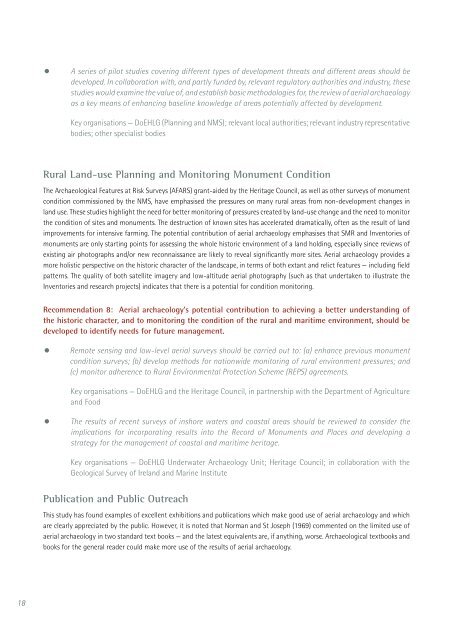Aerial Archaeology in Ireland - The Heritage Council
Aerial Archaeology in Ireland - The Heritage Council
Aerial Archaeology in Ireland - The Heritage Council
You also want an ePaper? Increase the reach of your titles
YUMPU automatically turns print PDFs into web optimized ePapers that Google loves.
18<br />
• A series of pilot studies cover<strong>in</strong>g different types of development threats and different areas should be<br />
developed. In collaboration with, and partly funded by, relevant regulatory authorities and <strong>in</strong>dustry, these<br />
studies would exam<strong>in</strong>e the value of, and establish basic methodologies for, the review of aerial archaeology<br />
as a key means of enhanc<strong>in</strong>g basel<strong>in</strong>e knowledge of areas potentially affected by development.<br />
Key organisations — DoEHLG (Plann<strong>in</strong>g and NMS); relevant local authorities; relevant <strong>in</strong>dustry representative<br />
bodies; other specialist bodies<br />
Rural Land-use Plann<strong>in</strong>g and Monitor<strong>in</strong>g Monument Condition<br />
<strong>The</strong> Archaeological Features at Risk Surveys (AFARS) grant-aided by the <strong>Heritage</strong> <strong>Council</strong>, as well as other surveys of monument<br />
condition commissioned by the NMS, have emphasised the pressures on many rural areas from non-development changes <strong>in</strong><br />
land use. <strong>The</strong>se studies highlight the need for better monitor<strong>in</strong>g of pressures created by land-use change and the need to monitor<br />
the condition of sites and monuments. <strong>The</strong> destruction of known sites has accelerated dramatically, often as the result of land<br />
improvements for <strong>in</strong>tensive farm<strong>in</strong>g. <strong>The</strong> potential contribution of aerial archaeology emphasises that SMR and Inventories of<br />
monuments are only start<strong>in</strong>g po<strong>in</strong>ts for assess<strong>in</strong>g the whole historic environment of a land hold<strong>in</strong>g, especially s<strong>in</strong>ce reviews of<br />
exist<strong>in</strong>g air photographs and/or new reconnaissance are likely to reveal significantly more sites. <strong>Aerial</strong> archaeology provides a<br />
more holistic perspective on the historic character of the landscape, <strong>in</strong> terms of both extant and relict features — <strong>in</strong>clud<strong>in</strong>g field<br />
patterns. <strong>The</strong> quality of both satellite imagery and low-altitude aerial photography (such as that undertaken to illustrate the<br />
Inventories and research projects) <strong>in</strong>dicates that there is a potential for condition monitor<strong>in</strong>g.<br />
Recommendation 8: <strong>Aerial</strong> archaeology’s potential contribution to achiev<strong>in</strong>g a better understand<strong>in</strong>g of<br />
the historic character, and to monitor<strong>in</strong>g the condition of the rural and maritime environment, should be<br />
developed to identify needs for future management.<br />
• Remote sens<strong>in</strong>g and low-level aerial surveys should be carried out to: (a) enhance previous monument<br />
condition surveys; (b) develop methods for nationwide monitor<strong>in</strong>g of rural environment pressures; and<br />
(c) monitor adherence to Rural Environmental Protection Scheme (REPS) agreements.<br />
Key organisations — DoEHLG and the <strong>Heritage</strong> <strong>Council</strong>, <strong>in</strong> partnership with the Department of Agriculture<br />
and Food<br />
• <strong>The</strong> results of recent surveys of <strong>in</strong>shore waters and coastal areas should be reviewed to consider the<br />
implications for <strong>in</strong>corporat<strong>in</strong>g results <strong>in</strong>to the Record of Monuments and Places and develop<strong>in</strong>g a<br />
strategy for the management of coastal and maritime heritage.<br />
Key organisations — DoEHLG Underwater <strong>Archaeology</strong> Unit; <strong>Heritage</strong> <strong>Council</strong>; <strong>in</strong> collaboration with the<br />
Geological Survey of <strong>Ireland</strong> and Mar<strong>in</strong>e Institute<br />
Publication and Public Outreach<br />
This study has found examples of excellent exhibitions and publications which make good use of aerial archaeology and which<br />
are clearly appreciated by the public. However, it is noted that Norman and St Joseph (1969) commented on the limited use of<br />
aerial archaeology <strong>in</strong> two standard text books — and the latest equivalents are, if anyth<strong>in</strong>g, worse. Archaeological textbooks and<br />
books for the general reader could make more use of the results of aerial archaeology.

















